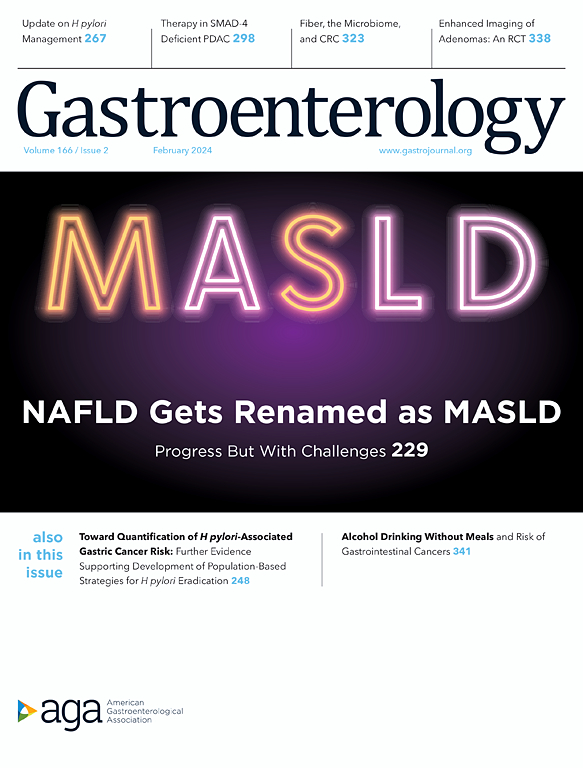Cost-effectiveness of regular surveillance versus endoscopy at need for patients with Barrett’s esophagus: economic evaluation alongside the BOSS randomized controlled trial
IF 25.7
1区 医学
Q1 GASTROENTEROLOGY & HEPATOLOGY
引用次数: 0
Abstract
Introduction
The Barrett’s esophagus surveillance study (BOSS) was the first randomized study of surveillance. This study reports the costs and quality of life outcomes from the BOSS trial and models the outcomes and cost-effectiveness of surveillance beyond the follow up period of the BOSS study. This trial showed similar stages and rates of esophageal cancer in both arms, but the regular surveillance arm did identify more high-grade dysplasia after a median of 12.8 years follow up.Methods
We used a decision tree model based on results from BOSS to conduct a cost-effectiveness analysis of costs and quality adjusted life years (QALYs). A Markov model was used to extrapolate costs and outcomes over a further 10 years after the trial had ended representing a 22.8 year time horizon. The proportion with high grade dysplasia and QALYs were derived from the randomized trial.Results
The total costs associated with two yearly surveillance was $5,309 vs. $3,182 in the at need arm. Total QALY in the two-yearly endoscopy arm were 8.647 as compared to 8.629 in the at need arm. Compared with at need endoscopy, two-yearly surveillance costs $115,563/QALY gained. In the sensitivity analyses around assumptions on the proportion of high-grade dysplasia that is undetected in the at need endoscopy arm, surveillance had an incremental cost effectiveness ratio of $94,513/QALY for the best-case and $146,272/QALY for the worst-case scenario.Conclusion
BE surveillance every 2-3 years is unlikely to be a cost-effective strategy. Guidelines should take this into account when deciding surveillance intervalsBarrett食管患者定期监测与内窥镜检查的成本效益:BOSS随机对照试验的经济评估
Barrett食管监测研究(BOSS)是第一个随机监测研究。本研究报告了BOSS试验的成本和生活质量结果,并模拟了BOSS研究随访期后监测的结果和成本效益。该试验显示两组患者的食管癌分期和发生率相似,但常规监测组在中位随访12.8年后确实发现了更多的高级别不典型增生。方法采用基于BOSS结果的决策树模型对成本和质量调整生命年(QALYs)进行成本-效果分析。使用马尔可夫模型来推断试验结束后10年的成本和结果,代表22.8年的时间范围。高度发育不良和QALYs的比例来源于随机试验。结果与两年监测相关的总费用为5309美元,而急需监测组为3182美元。两年内窥镜组的总质量aly为8.647,而急诊组为8.629。与急需的内窥镜检查相比,两年的监测费用为115,563美元/QALY。在敏感性分析中,假设在需要的内窥镜检查中未检测到的高度发育不良的比例,监测的增量成本效益比在最佳情况下为94,513美元/QALY,在最坏情况下为146,272美元/QALY。结论每2-3年进行be监测不太可能是一种具有成本效益的策略。指南在决定监测间隔时应考虑到这一点
本文章由计算机程序翻译,如有差异,请以英文原文为准。
求助全文
约1分钟内获得全文
求助全文
来源期刊

Gastroenterology
医学-胃肠肝病学
CiteScore
45.60
自引率
2.40%
发文量
4366
审稿时长
26 days
期刊介绍:
Gastroenterology is the most prominent journal in the field of gastrointestinal disease. It is the flagship journal of the American Gastroenterological Association and delivers authoritative coverage of clinical, translational, and basic studies of all aspects of the digestive system, including the liver and pancreas, as well as nutrition.
Some regular features of Gastroenterology include original research studies by leading authorities, comprehensive reviews and perspectives on important topics in adult and pediatric gastroenterology and hepatology. The journal also includes features such as editorials, correspondence, and commentaries, as well as special sections like "Mentoring, Education and Training Corner," "Diversity, Equity and Inclusion in GI," "Gastro Digest," "Gastro Curbside Consult," and "Gastro Grand Rounds."
Gastroenterology also provides digital media materials such as videos and "GI Rapid Reel" animations. It is abstracted and indexed in various databases including Scopus, Biological Abstracts, Current Contents, Embase, Nutrition Abstracts, Chemical Abstracts, Current Awareness in Biological Sciences, PubMed/Medline, and the Science Citation Index.
 求助内容:
求助内容: 应助结果提醒方式:
应助结果提醒方式:


